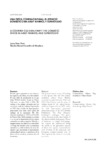Una fiesta contracultural: el espacio doméstico en Andy Warhol y Superstudio

Ver/Abrir
Use este enlace para citar
http://hdl.handle.net/2183/24338
Excepto si se señala otra cosa, la licencia del ítem se describe como Atribución-CompartirIgual 4.0 España
Colecciones
Metadatos
Mostrar el registro completo del ítemTítulo
Una fiesta contracultural: el espacio doméstico en Andy Warhol y SuperstudioTítulo(s) alternativo(s)
A Counter-Cultural Party: The Domestic Space in Andy Warhol and SuperstudioFecha
2019Cita bibliográfica
Sanz Haro, J., & Maruri González de Mendoza, N. (2019). Una fiesta contracultural. BAc Boletín Académico. Revista De investigación Y Arquitectura contemporánea, 9, 93-108. https://doi.org/10.17979/bac.2019.9.0.4633
Resumen
[Resumen] El texto que se presenta es una mirada a dos espacios, uno físico, otro solo soñado: El viejo taller de producción en el que Andy Warhol inventó el pop en Nueva York entre los años 1963 a 1969, The Factory, y los collages dibujados por los arquitectos radicales italianos Superstudio en 1971 bajo el título de Supersuperficie, presentados más tarde como parte del catálogo de la exposición The New Domestic Landscape en 1972 en el MoMA de Nueva York. Dicha mirada se centrará a su vez en la observación de los objetos contenidos en ambos espacios. Muebles o simples enseres, los objetos son entendidos a lo largo del artículo como herramientas sustantivas y conformadoras de estos dos espacios que representan el pensamiento contracultural europeo y americano de la década de los sesenta y primeros años de los setenta. [Abstract] The present text is a way of looking to two spaces: The old New Yorker workshop where Andy Warhol invented the pop between 1963 and 1969, The Factory, and the series of collages drawn by the radical Italian architects Superstudio in 1971 under the title Supersurface, presented afterwards as part of the 1972 MoMa Exhibition: The New Domestic Landscape´s catalogue. The given look is focused on the observation of the objects within both spaces. Pieces of furniture or simply belongings, the objects are understood along the article as the generative aspects of these two spaces, representative both of them of the American and European counter-cultural way of thinking from the sixties to the early seventies.
Palabras clave
Contracultura
Objeto
Pop
Antidiseño
Objet-Trouvé
Counter-culture
Object
Pop
Anti-desing
Objeto
Pop
Antidiseño
Objet-Trouvé
Counter-culture
Object
Pop
Anti-desing
Versión del editor
Derechos
Atribución-CompartirIgual 4.0 España
ISSN
0213-3474






